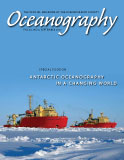Article Abstract
Extensive sampling in many regions of the Southern Ocean has demonstrated that surface water concentrations of dissolved Fe are low enough to limit phytoplankton growth. In contrast, there is currently no evidence that other bioactive elements (e.g., Mn, Zn, Co) are similarly limiting. Although atmospheric input of dissolved Fe to Southern Ocean surface waters appears to be low, resuspension of sediments from shallow regions around islands and the Antarctic coastline can inject significant amounts of Fe into the surrounding waters, stimulating primary production and providing a natural laboratory for studying the response of biological systems to natural Fe fertilization processes. Future work using a multitracer approach across seasonal transitions would be particularly beneficial to quantifying input processes and fluxes. However, it would require the design of new sampling platforms that can accommodate trace metal sampling under extreme weather conditions.

